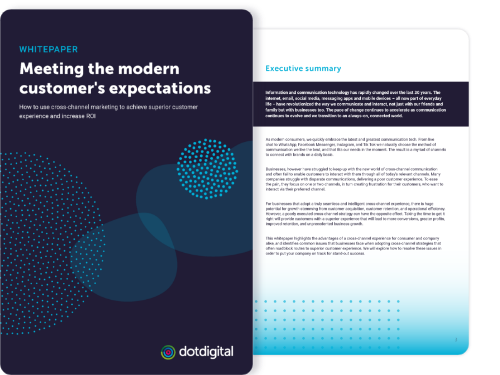

Why cross-channel marketing matters

Customer expectations have changed.
As technology evolves, modern customers are quick to embrace new channels. Naturally, they gravitate towards channels they like best, and that meet their needs in the moment. As a result, there are a countless number of channels being used by customers on a daily basis.
To keep up with these demands, brands have to go to the customer. That means expanding the number of channels in your marketing stack.
But even that’s not enough for the modern consumer. They want a connected journey; a seamless experience. And that requires marketers to use the tools that empower them to fully embrace a cross-channel marketing strategy.
What is cross-channel marketing?
Cross-channel marketing is a brand’s ability to connect with customers on a range of communication channels, such as email, SMS, social media, apps, and more.
The goal of this type of marketing is to connect with customers and continue conversations across the channel they choose to use throughout all stages of the customer lifecycle. As marketers, your goal is not only to grow your marketing database and acquire new customers. Cross-channel marketing enables you to keep the conversation going so customers are able to connect with you whenever and wherever the need for your services arises.
Why is cross-channel marketing important?
Your ability to meet modern customer expectations will determine a lot about your business. If you want to smash your marketing goal – to grow your brand, drive conversions, and boost customer retention – you need to adopt cross-channel marketing strategy.
Failing to meet cross-channel expectations results in a poor customer experience and that, in turn, causes greater customer turnover and stilt’s brand growth.
What’s the difference between cross-channel and multichannel?
Cross-channel is about delivering a connected experience across different channels. A single campaign is identifiably yours, no matter the channel customers use. For example, when a prospective customer subscribes to your email newsletter, a welcome email is automatically triggered. A week later, the receive an SMS reminding them about their ‘welcome’ discount code. This is a seamless, connected experience for the customer.
A multichannel experience is much less connected. It is simply using multiple channels to interact with customers. That’s not to say campaigns aren’t cohesive, but they aren’t as seamless or smooth. It requires a lot more work for you. Automated campaigns such as the onboarding example given above are not possible.
What are the benefits of cross-channel marketing?
Demand for cross-channel experiences is on the rise for one simple reason: customers want convenience. They don’t want to have to hunt around for the best way to get in touch with their favorite brands. The harder you make it, the less likely they are to convert.
Cross-channel marketing enables brands to communicate on customers’ preferred channels. Because these communications are connected by a cross-channel marketing platform, you will be able to deliver personalized and relevant messages no matter where they are in the customer lifecycle.
Marketing messages during the onboarding process are very different compared to messages to loyal customers who have been with your brand for years. Seamless cross-channel marketing allows you to better understand who the customer is, what drives them, and how best to drive them towards conversion.
What problems can cross-channel marketing solve?
Disjointed customer experiences can be chaotic and confusing for the customers. Sending an abandoned cart email after they’ve converted; a 15% off discount code via email and a 20% off offer through SMS; a ‘we miss you’ at the same time as a replenishment message; these are all ways unconnected communications can damage customer relationships and leave them looking elsewhere.
A cross-channel strategy connects your channels, unifies your data, and guarantees the consistency and relevancy of all your communications.
What does the future of cross-channel marketing look like?
The best thing about cross-channel marketing is that it’s not going anywhere. As artificial intelligence (AI) and machine learning continue to innovate, cross-channel marketing platforms like Dotdigital will continue to provide top-of-the-range solutions for marketers.
Functionalities like single customer view (SCV), eRFM customer modeling, AMP, and predictive recommendations will empower marketers to break the boundaries of customer expectations.
Contents
Jenna Paton, Content Marketing Manager
Jenna expertly writes thought-leadership content about cross-channel marketing and customer engagement and manages the creation and execution of Dotdigital's content marketing strategy.

Meeting modern customers' expectations
With a better understanding of customer expectations, you can build experiences that resound with your audience. Discover what’s driving customer behavior in our latest whitepaper.
Get your copy nowStay on top
Get the latest and greatest marketing insight delivered to you weekly
Your email address will be handled in accordance with our Privacy Policy. We gather data around email opens & clicks using standard technologies including clear gifs to help us monitor and improve our newsletter.

